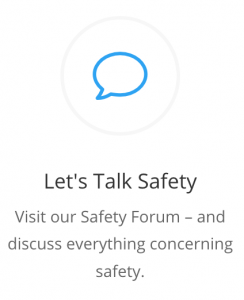Hazard Communication & Chemical Safety: GHS Labels and Pictograms
Hazard Communication & Chemical Safety: GHS Labels and Pictograms
You can find the show notes to each episode, links to the information mentioned on the podcast, the social media platforms we’re on, and anything else related to the podcast at WarehouseSafetyTips.com.
If you’re a seasoned Podcast Listener, this podcast will be different from most you listen to. It’s based on exactly what the name implies – Warehouse Safety Tips. And since the people in that industry are busy – we know time is money so each episode will be as short and to the point as possible.
And now that all that is out of the way – let’s get to the Podcast!
Hazard Communication & Chemical Safety: GHS Labels and Pictograms
Understanding how to correctly label chemicals and identify hazards is critical for keeping everyone in the facility safe. Week 3 of our Hazard Communication & Chemical Safety series focuses on labeling and pictograms, essential components of the Globally Harmonized System (GHS).
A strong Safety Culture includes consistent, clear labeling and hazard recognition. It also relies on employees identifying the risks involved with each chemical or substance they handle.
GHS labels are designed to communicate specific hazards quickly. They use standardized pictograms, signal words, hazard statements, and precautionary guidance. These labels are required on all primary containers and must stay intact and legible. Unfortunately, many accidents happen because labels are missing, unreadable, or incorrect. That’s why clear and accurate labeling practices are key to chemical safety.
Here are a few tips to assist you with proper labeling and understanding pictograms:
- Know the GHS pictograms. Each symbol represents a specific hazard. From the flame icon indicating flammable materials to the skull and crossbones for toxic substances, recognizing these symbols at a glance helps prevent unsafe exposure and improper handling.
- Always check for the required elements on a GHS label. These include the product identifier, signal word, pictogram(s), hazard statement, precautionary statement, and supplier information. If any of these are missing, the label does not meet safety standards and should be reported.
- Label all secondary containers. If you transfer a chemical into a smaller or temporary container, it must also be labeled unless the person who moved it uses it immediately. That label should still include the product name and appropriate hazard information.
- Don’t ignore worn or damaged labels. Faded or peeling labels reduce the chance of proper identification. Replace them right away and report the issue to your supervisor.
- Use real-world examples to stay alert. Watch out for common mistakes, like handwritten labels missing hazard information or using abbreviations others may not understand. Ask or refer to the safety data sheet (SDS) when in doubt.
Strong labeling practices don’t just meet regulation requirements—they prevent injuries, reduce confusion, and help create a more organized and efficient facility. By taking time to review and understand labels and pictograms, you’re actively helping to protect yourself and your team.
Accurate labeling is not a suggestion. It’s part of your responsibility to maintain a safe working environment. Let’s make sure every label tells the whole story.
Thank you for being part of another episode of Warehouse Safety Tips.
Until we meet next time – have a great week, and STAY SAFE!
Before moving on – here’s a word from one of our sponsors.
If you’ve ever been to or worked in a warehouse – you know just how important safety is to management and staff. It’s almost impossible to go 10 steps without seeing Safety Tape, Angles, Signs, and/or products.
These items show us how to be safe and avoid danger in the workplace. And if you’re looking for the best products to make this happen – look no further than Mighty Line!
Mighty Line Floor Signs / Floor Markings offer the best industrial products!
Go to MightyLineTape.com/SafetyTips to request a Sample Pack of their incredible Safety Signs and Floor Markings.
What makes Mighty Line the superior choice in keeping your facility safe and productive?
- Mighty Line Tape is the strongest floor tape on the market and has a beveled edge that increases durability for industrial brush scrubbers, forklifts, and heavy industrial wheel traffic.
- Easy installation and removal thanks to Mighty Line’s peel-and-stick backing. You can apply and reapply it during installation – and it leaves no sticky residue should you need to remove it. This allows the ability to change workflow areas quickly and easily – and not have the downtime associated with painting or using floor markings that leave behind a mess when you remove them.
- Mighty Line Tape is 7 times thicker than the average Safety Floor Tape.
- Mighty Line’s Signs and Markings come in various shapes, colors, and sizes. And if they don’t have what you’re looking for in stock – their Customize It Program allows you to create exactly what you’re looking for.
- Mighty Line offers a Limited 3-Year Warranty on their Floor Signs and Markings.
- And last but certainly not least – Mighty Line Products are Patented and PROUDLY Made in the USA!
We’re proud to have Mighty Line as THE Official Floor Sign / Floor Marking Company for the Warehouse Safety Tips Podcast and Site.
Again – Go to MightyLineTape.com/SafetyTips to request a Sample Pack of their incredible Safety Signs and Floor Markings.
If you visit WarehouseSafetyTips.com – you’ll find the Show Notes for this episode.
Thank you for listening to Warehouse Safety Tips – and have a SAFE day!
Like and follow us on these Social Platforms:
https://www.instagram.com/warehousesafetytipspodcast/
https://www.twitter.com/YourSafetyTips
https://www.facebook.com/warehousesafetytips


